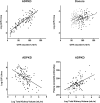Kidney function and plasma copeptin levels in healthy kidney donors and autosomal dominant polycystic kidney disease patients
- PMID: 24993447
- PMCID: PMC4152815
- DOI: 10.2215/CJN.08690813
Kidney function and plasma copeptin levels in healthy kidney donors and autosomal dominant polycystic kidney disease patients
Abstract
Background and objectives: Plasma copeptin, a marker of arginine vasopressin, is elevated in patients with autosomal dominant polycystic kidney disease and predicts disease progression. It is unknown whether elevated copeptin levels result from decreased kidney clearance or as compensation for impaired concentrating capacity. Data from patients with autosomal dominant polycystic kidney disease and healthy kidney donors before and after donation were used, because after donation, overall GFR decreases with a functionally normal kidney.
Design, setting, participants, & measurements: Data were obtained between October of 2008 and January of 2012 from healthy kidney donors who visited the institution for routine measurements predonation and postdonation and patients with autosomal dominant polycystic kidney disease who visited the institution for kidney function measurement. Plasma copeptin levels were measured using a sandwich immunoassay, GFR was measured as (125)I-iothalamate clearance, and urine concentrating capacity was measured as urine-to-plasma ratio of urea. In patients with autosomal dominant polycystic kidney disease, total kidney volume was measured with magnetic resonance imaging.
Results: Patients with autosomal dominant polycystic kidney disease (n=122, age=40 years, men=56%) had significantly higher copeptin levels (median=6.8 pmol/L; interquartile range=3.4-15.7 pmol/L) compared with donors (n=134, age=52 years, men=49%) both predonation and postdonation (median=3.8 pmol/L; interquartile range=2.8-6.3 pmol/L; P<0.001; median=4.4 pmol/L; interquartile range=3.6-6.1 pmol/L; P<0.001). In donors, copeptin levels did not change after donation, despite a significant fall in GFR (from 105 ± 17 to 66 ± 10; P<0.001). Copeptin and GFR were significantly associated in patients with autosomal dominant polycystic kidney disease (β=-0.45, P<0.001) but not in donors. In patients with autosomal dominant polycystic kidney disease, GFR and total kidney volume were both associated significantly with urine-to-plasma ratio of urea (β=0.84, P<0.001; β=-0.51, P<0.001, respectively).
Conclusions: On the basis of the finding in donors that kidney clearance is not a main determinant of plasma copeptin levels, it was hypothesized that, in patients with autosomal dominant polycystic kidney disease, kidney damage and associated impaired urine concentration capacity determine copeptin levels.
Keywords: ADPKD; cystic kidney; urea; vasopressin.
Copyright © 2014 by the American Society of Nephrology.
Figures




Similar articles
-
Relationship of copeptin, a surrogate marker for arginine vasopressin, with change in total kidney volume and GFR decline in autosomal dominant polycystic kidney disease: results from the CRISP cohort.Am J Kidney Dis. 2013 Mar;61(3):420-9. doi: 10.1053/j.ajkd.2012.08.038. Epub 2012 Oct 22. Am J Kidney Dis. 2013. PMID: 23089511 Free PMC article.
-
Vasopressin, copeptin, and renal concentrating capacity in patients with autosomal dominant polycystic kidney disease without renal impairment.Clin J Am Soc Nephrol. 2012 Jun;7(6):906-13. doi: 10.2215/CJN.11311111. Epub 2012 Apr 19. Clin J Am Soc Nephrol. 2012. PMID: 22516290
-
Copeptin, a surrogate marker of vasopressin, is associated with disease severity in autosomal dominant polycystic kidney disease.Clin J Am Soc Nephrol. 2011 Feb;6(2):361-8. doi: 10.2215/CJN.04560510. Epub 2010 Oct 7. Clin J Am Soc Nephrol. 2011. PMID: 20930090 Free PMC article.
-
Is serum copeptin a modifiable biomarker in autosomal dominant polycystic kidney disease?World J Nephrol. 2018 Mar 6;7(2):51-57. doi: 10.5527/wjn.v7.i2.51. World J Nephrol. 2018. PMID: 29527508 Free PMC article. Review.
-
Vasopressin and Copeptin in health and disease.Rev Endocr Metab Disord. 2019 Sep;20(3):283-294. doi: 10.1007/s11154-019-09509-9. Rev Endocr Metab Disord. 2019. PMID: 31656992 Review.
Cited by
-
The urine-to-plasma urea concentration ratio is associated with eGFR and eGFR decline over time in a population cohort.Nephrol Dial Transplant. 2023 Dec 20;39(1):122-132. doi: 10.1093/ndt/gfad131. Nephrol Dial Transplant. 2023. PMID: 37381173 Free PMC article.
-
Copeptin in the diagnosis of vasopressin-dependent disorders of fluid homeostasis.Nat Rev Endocrinol. 2016 Mar;12(3):168-76. doi: 10.1038/nrendo.2015.224. Epub 2016 Jan 22. Nat Rev Endocrinol. 2016. PMID: 26794439 Review.
-
Energy-Dependent Urea Transports in Mammals and their Functional Consequences.Subcell Biochem. 2025;118:193-228. doi: 10.1007/978-981-96-6898-4_10. Subcell Biochem. 2025. PMID: 40637983 Review.
-
The Emerging Role of Copeptin.Clin Biochem Rev. 2021 Feb;42(1):17-25. doi: 10.33176/AACB-20-00001. Clin Biochem Rev. 2021. PMID: 35722630 Free PMC article. Review.
-
Predicting autosomal dominant polycystic kidney disease progression: review of promising Serum and urine biomarkers.Front Pediatr. 2023 Nov 10;11:1274435. doi: 10.3389/fped.2023.1274435. eCollection 2023. Front Pediatr. 2023. PMID: 38027263 Free PMC article. Review.
References
-
- Grantham JJ: Lillian Jean Kaplan International Prize for advancement in the understanding of polycystic kidney disease. Understanding polycystic kidney disease: A systems biology approach. Kidney Int 64: 1157–1162, 2003 - PubMed
-
- Meijer E, Boertien WE, Zietse R, Gansevoort RT: Potential deleterious effects of vasopressin in chronic kidney disease and particularly autosomal dominant polycystic kidney disease. Kidney Blood Press Res 34: 235–244, 2011 - PubMed
-
- Hanaoka K, Guggino WB: cAMP regulates cell proliferation and cyst formation in autosomal polycystic kidney disease cells. J Am Soc Nephrol 11: 1179–1187, 2000 - PubMed
-
- Meijer E, Gansevoort RT, de Jong PE, van der Wal AM, Leonhard WN, de Krey SR, van den Born J, Mulder GM, van Goor H, Struck J, de Heer E, Peters DJ: Therapeutic potential of vasopressin V2 receptor antagonist in a mouse model for autosomal dominant polycystic kidney disease: Optimal timing and dosing of the drug. Nephrol Dial Transplant 26: 2445–2453, 2011 - PubMed
-
- Torres VE, Wang X, Qian Q, Somlo S, Harris PC, Gattone VH, 2nd: Effective treatment of an orthologous model of autosomal dominant polycystic kidney disease. Nat Med 10: 363–364, 2004 - PubMed
MeSH terms
Substances
LinkOut - more resources
Full Text Sources
Other Literature Sources
Medical

